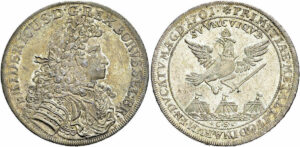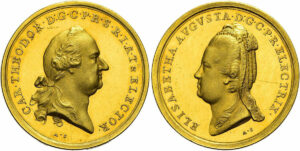Special Collections at Gorny & Mosch
From 6-8 March 2023, auctions 293 “Ancient Coins” and 294 “Selected Coins and Medals from the Middle Ages to Modern Times” will be held by Gorny & Mosch in Munich. Two splendid printed catalogues complement the sales.
Auction 293
More than 800 ancient coins will be auctioned off on 6 and 7 March 2023 by the Munich auction house Gorny & Mosch at their business premises. A highlight of this sale is the Prof. Dr. Wolfram Weiser Collection (1954-2022). It contains over 140 late Roman and Byzantine lead seals, which come with detailed scholarly descriptions and are presented according to research standards.
Moreover, coins from the following collections are on offer:
- Greek coins from a south-west German private estate
- a collection of coins from the Roman Republic
- Roman coins from the Dr. R.K. Collection
Auction 294
The auction of modern issues on 8 March 2023 comprises as many as 750 coins and medals. Among them is a part of the important Dr. Fritz Spruth Collection with mining and yield issues, especially from Hessian territories.
In addition, the following collections will be on sale:
- German bracteates and medieval Europe
- Germany up to 1871, especially the Dr. R.K. Collection (Special Collection Bavaria)
- Germany after 1871, Austria-Hungary, Europe and World Coins,
- Islamic coins from the Hinrichs Collection, part II
The offer of auctions 293 and 294 at a glance:
- Celts – 0001-0018
- Greeks – 0019-0373
- Roman Provincial Coinage – 0374-0389
- Roman Republic – 0390-0464
- Roman Imperial Period – 0465-0649
- Byzantium – 0650-0673
- Migration Period – 0674-0676
- Prof. Dr. Wolfram Weiser Collection – 0677-0817
- Mining and yield issues (Dr. Fritz Spruth Collection) – 1001-1140
- Medieval Germany – 1141-1165
- Medieval Europe – 1166-1175
- Germany up to 1871 – 1176-1293
- Germany up to 1871 – 1294-1468
- Germany after 1871 – 1469-1536
- Medals – 1537-1543
- Austria-Hungary – 1544-1572
- Europe – 1573-1648
- World Coins – 1649-1655
- Islamic issues (Hinrichs Collection, part II) – 1656-1754

Ancient Coins
- No. 90: Greeks. Sicily. Naxos. Drachm ø 21mm (5.50g). 530 – 490 BC. Extremely rare! Fine toning, rv. slightly weak strike, otherwise extremely fine. Estimate: 40,000 euros.The city of Naxos on Sicily was founded by Greek colonists in 735 BC as their first colony on the island. Unfortunately, not much is known about the city’s history prior to 493 BC. In that year, it was besieged and subjugated by Hippocrates, the tyrant of neighbouring Gela.
- No. 337: Greeks. Sasanians. Vahran II, AD 276 – 293. Dinar ø 21mm (7.32g). Gold! Very rare! Obv. minor weak strike at the globe, rv. minor double strike, extremely fine. Estimate: 7,500 euros.
Vahran II was one of the most active and politically successful early rulers of the Sasanians. Whereas later issues depict him together with his wife and his two sons, this extremely rare early coin features him alone on the obverse. The curled-up form of the wings only appears on very rare varieties of the drachms that are depicted in publications issued before 2011, including the SNS, but have been proven to be authentic several times by now.

- No. 465: Roman Empire. Augustus, 27 BC – AD 14. Aureus ø 20mm (7.92g). 20 – 19 BC. Gold! Very rare! Minor scratch, extremely fine. Estimate: 15,000 euros.
The reverse legend signis receptis (“for the recovery of the standards”) refers to the recovery of the military standards that had been lost to the Parthians in the failed campaigns of Crassus in 53 BC and Antonius in 36 BC. Augustus succeeded in retrieving these standards in 20 BC by threatening the Parthians with war. In the centre is the clipeus virtutis, the shield of virtue that was awarded to Augustus in 27 BC by the Senate and the people for restoring the lawful order of the state, as he said himself, by means of his “virtue, mercy, justice and piety” (virtus, clementia, iustitia, pietas). (Augustus, The Deeds of the Divine Augustus, chpt. 34). This aureus was probably minted shortly after these events, i.e., in 20/19 BC. The reverse thus combines in a special way the reference to a topical political event with one of the symbols of the informal legitimation of Augustus’ rule, the recognition of the extraordinary services he rendered to the state.
- No. 630: Roman Empire. Maximian Herculius, AD 285 – 310. Aureus ø 18mm (5.22g). AD 294. Gold! Very rare! Only 3 known specimens on Coinarchives! Rv. slightly smoothed in the field on the right, extremely fine. Estimate: 17,000 euros.
The reverse of this aureus features the second one of the Twelve Labours (dodecathlon) of Heracles: Heracles fighting the Lernaean Hydra. The depiction of the Labours of Heracles is a recurring theme in various genres of ancient art – from vase painting to numismatics. The motif of Heracles fighting the Hydra depicted on this aureus can be found in a rather similar way on the coins of Phaistos (Crete) of the late 4th century BC. Researchers have suggested that the motif might be based on a lost artwork of an ancient master painter or sculptor, probably even a group of statues by Lysippos (*probably 400/399 BC in Sikyon; †around the end of the 4th century BC). Therefore, the reverse of this coin can be interpreted as an allegorical reference to the constant fight of the Roman Emperor against all the enemies of the empire, which are represented by the many heads of the Hydra.
- No. 815. Prof. Dr. Wolfram Weiser Collection. Byzantine Lead Seals. Aimery of Limoges, Latin Patriarch of Antioch. Two-sided seal. ø 37mm (43.52g). Ca. AD 1125 – 1150. Yellow-brown patina, extremely fine. Estimate: 800 euros.
An example for the Prof. Dr. Wolfram Weiser Collection, this Byzantine lead seal depicts Aimery of Limoges († around 1193) on the obverse. He was a prelate of the Catholic Church in Outremer and the Latin Patriarch of Antioch from 1140 until his death. During his long episcopate, he was one of the most powerful people in the Principality of Antioch besides the Prince, with whom he often was in conflict. He was also one of the leading intellectuals in the Latin East. The reverse depicts Peter, the patron saint of Antioch.

Modern Coins
- No. 1004: German Coins and Medals up to 1871. Brandenburg / Prussia. Frederick III / I, 1688 – 1713. Reichstaler 1701 CS, Berlin. Yield of the Rothenburg mines in the Duchy of Magdeburg. 29.20 g. Showpiece. Fine toning, slightly weak strike, about brilliant uncirculated. Ex Dr. Fritz Spruth Collection. Estimate: 9,000 euros.
- No. 1059: German Coins and Medals up to 1871. Hesse-Kassel. Wilhelm VI, 1637 – 1663. Ducat n.d. AG (1649 / 1651), Kassel. Yield issue. Probably commemorating the death of his mother Amalie Elisabeth of Hanau-Münzenberg. Gold! Extremely rare. Fine gold toning, slightly bent, tiny bend at the edge, extremely fine. Probably minted from the gold of the Korbach mine. Ex Dr. Fritz Spruth Collection. Estimate: 25,000 euros.
- No. 1129 German Coins and Medals up to 1871. Wied – Runkel. Christian Ludwig, 1762 – 1791. Reichstaler 1762 (minted in 1767) SF, Frankfurt am Main. Yield of the Weyer mine. Commemorating his wedding to Charlotte Sophia Augusta of Sayn-Wittgenstein-Sayn. Minted at the suggestion of the Weyer mine. Very rare. Mintage: 102 pieces. Showpiece. Magnificent toning, about brilliant uncirculated. Ex Dr. Fritz Spruth Collection. Estimate: 20,000 euros.
- No. 1256: German Coins and Medals up to 1871. Bavaria. Charles Theodore, 1777 – 1799. Ducat 1780 ST, Munich. Isar river gold ducat. 3.49 g. Gold! Very rare! Gem. About brilliant uncirculated. Ex Stack’s “The Kroisos Collection” (2008), 2609. Ex Louis E. Eliasberg Collection, American Numismatics Rarities (2005), 236. Ex John H. Clapp Collection, Stack’s 1942. Estimate: 15,000 euros.

- No. 1416: German Coins and Medals up to 1871. Jülich – Berg. Charles Theodore, 1742 – 1799. Gold medal of 15 ducats n.d. (1771), by Anton Schäffer. Probably commemorating his wife’s journey to the Netherlands and Düsseldorf. Gold! Extremely rare! Showpiece. Brilliant uncirculated. Estimate: 20,000 euros.
e-auction 295
On 22 March 2023 starting at 10 a.m., coins, medals and multiple lots from antiquity to modern times will be auctioned off online. The offer includes, among other things,
- Greek coins from a south-west German private estate
- coins from Palestine of the Prof. Dr. Claus-Hunno Hunzinger (1929-2021) Coll.
- further coins and bundles of the Gert Cleff Coll.
- Roman coins of the Dr. R.K. Coll.
- Germany up to 1871, especially Bavaria from the Dr. R.K. Coll.
- Germany up to 1871 and Europe
- Islamic coins, especially from the Hinrichs Coll., Bremen
Viewing
The viewing takes place at Gorny & Mosch, Maximiliansplatz on the starting now:
Monday – Friday, 10 a.m. – 1 p.m. and 2:30 p.m. – 6 p.m; Sunday, 5 March 2023, from 10 a.m. – 6 p.m. and after prior appointment
All lots can be viewed in the online auction catalog.
For further information, visit the Gorny & Mosch website.




